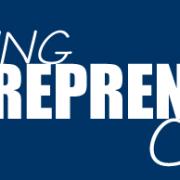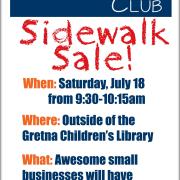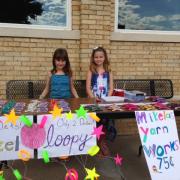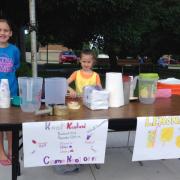The Young Entrepreneur Club helps kids ages 6 to 12 learn the basics of becoming an entrepreneur. Over the course of three sessions, the participants pick a product or service, create a business name and logo, and learn money management, communication and sales skills. At the final event, participants promote and sell their goods or services at a special “sidewalk sale” during a popular community event, Gretna Days.
Advanced Planning
The Young Entrepreneur Club was the result of a partnership between our public library and a local academic library. Casey Kralik, a technical services librarian at Bellevue University, approached us about the program, which her creative and business-savvy daughter inspired her to create. Casey felt moved to help the young people of our community learn some basic skills to become entrepreneurs.
We started planning about two months before the first club meeting. Casey created a great outline breaking business basics down into three class sessions: name, product and branding; money management; and sales and communication. (For handouts for each of the class sessions, download the materials under Attachments at right.)
Our vision for the club was to have local business owners act as guest speakers and/or leaders for the classes. The Gretna Area Chamber of Commerce encouraged us to solicit their members as mentors for the kids. While there was interest by the businesspeople, the commitment failed to come to fruition.
Marketing
As soon as we had chosen the dates and Casey had created a Young Entrepreneur Club logo, we created a flier that we posted at both library locations, around town, and on the library website and Facebook page. Casey and friends also shared this announcement on a private neighborhood Facebook page as well as the Nextdoor app.
In the few weeks leading up to the event, our two local papers posted a few stories about the club. A story by the Gretna Breeze was shared statewide on the Omaha World Herald’s website.
For the day of the event, we created and handed out fliers for the sidewalk sale. Parents and kids used the fliers to invite parade-goers to stop by the booths, see what the kids were selling and make some purchases. The location of the booths (near the parade route) and the fliers generated higher attendance.
Budgeting
The budget for this event was incredibly low: around $20. We bought name tags, fake money and posterboard half-sheets. That’s all. If any local businesses had been involved, we would have asked them to sponsor the few necessary supplies and maybe even upgrade the items.
Day-of-event Activity
For each of the three club meetings prior to the “finale” event, we posted the worksheets and information online for kids who could not make the meeting(s). This helped keep stress levels down for parents who had vacations and other activities planned. Kids who missed a session were able to work with their parents to easily cover what they had missed.
The classes were held in our meeting room. Since each class had about 15 kids, a few of the parents stayed in the room to help with the activities; this was helpful and much appreciated. Casey’s daughter often worked as a teacher’s assistant, handing out pencils, paper, name tags, etc. for each class. As we covered the materials, kids were encouraged to participate.
Before the sidewalk sale, staff, Casey, and parents helped set up the tables and chairs. After the sale, parents and kids helped the library staff put away the tables and chairs.
Casey had a last-minute idea to create a certificate of completion for each child who participated in the sale. I quickly put this together and handed them out to the kids. The smiles on the kids’ faces proved that this was an excellent add-on and gave the event closure.
Program Execution
Since the sale was held on a mid-July morning, our biggest issue was the heat. There wasn’t a good shady place for the kids’ tables. Fortunately, they could come inside to cool down for a while, and some parents used umbrellas to help provide shade. Still, we were perfectly located — an easy distance from the parade route and along the most popular street to park on as people headed toward the parade.
We forgot to count participation for the first half hour or so, but we counted that 100 people had participated with 13 kid entrepreneurs (some working their businesses together). Overall, there was a fun buzz to the event, and many happy customers created by our young entrepreneurs. We also received quite a few compliments from patrons the following week.
One issue arose because several kids sold a similar item (drinks). When a parent complained, we were unable to really do anything to adjust the format. We just hoped they learned about competition and/or saturated markets. It appeared that the parent did understand that we weren’t able to address or change that issue without causing even more issues. (In the end, the parent and kids did not participate in the sidewalk sale.)
Advice
Try to discuss the classes, activities and sale idea with a few kids and their parents before it all gets started. Not only would you generate some ideas and interest, but you could get them to think of some potential problems, such as having the same product. You could help to brainstorm the solutions while encouraging their participation.
For us, the biggest challenge was the time of year. Summer is traditionally our busiest at the library, and this event was leading up to the biggest community event of the year. We also need to figure out a way to shade the kids better without upping the budget too much.
Finally, we hope to get local business people involved in the future. Casey led every one of the sessions — not that it was a bad thing. However, we think the kids would have been excited to have actual businesspeople from our community take an interest in what they were doing.





